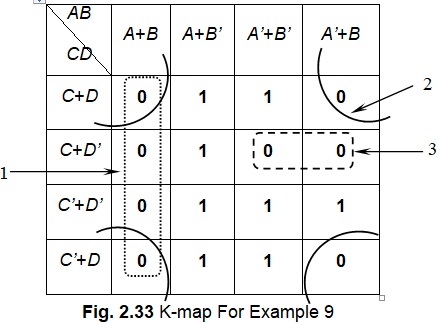So far, we have discussed only the sum-of-products expressions. We now discuss the reduction process in the POS form. It may be noted that, because of the dual nature of binary systems, any procedure or rule that is valid in the SOP form is equally valid in the POS form also.
Example 9: Simplify P = Π (0, 1, 2, 3, 8, 9, 10, 13)
The groupings are as shown in Fig. 2.33. These are:
Just like SOP functions, POS functions can also be represented in a K-map and the elimination of variables can be done as in the case of SOP. However, the K-map designations of cells differ and the entries are 0s instead of 1s. The four-variable K-map off a POS system is shown in Fig. 2.32.
The cells are numbered from 0 to 15 as in the case of SOP form. However, the cell designations have been changed. In SOP form, the individual cells were designated as product functions like a′b′, a′b, etc. In the case of POS form, multiplication gets changed to summation For example, the Cell 0 is designated as A+B+C+D, Cell 1 is designated as A+B+C+D’, and so on. In this text, the cells are designated using capital letters to distinguish them from SOP form (not as a rule, but as a convenient arrangement). Further, for the same reason, we have replaced the number designation of 00, 01, etc. with A+B, A+B’, etc. on the top and sides of the map.
Example 9: Simplify P = Π (0, 1, 2, 3, 8, 9, 10, 13)
Solution: The Greek uppercase letter Π represents a POS expression, just as S represents an SOP expression. The entries in the POS cells must be 0s. The cells in which there are no entries must be filled with 1s. Just as in the case of the SOP form, here also we can have don’t-care terms. Reduction process is similar in both the SOP and POS forms. Notice that the POS terms are called maxterms. The K-map for Example 9 is shown in Fig. 2.33.
The groupings are as shown in Fig. 2.33. These are:
Group 1: A+B
Group 2: B+D
Group 3: A′+C+D′
The final POS result is
P = (A+B)(B+D)(A′+C+D’) (2.33)
Simplification of POS Expressions with Don’t-Care Terms:
Example 10: Let us now introduce don’t care terms in cells 4, 5, 11, 14, and 15 of Example 9. The new function is P = Π (0, 1, 2, 3, 8, 9, 10, 13) + d (4, 5, 11, 14, 15). Obtain its reduction.
Solution: The K-map for this is shown in Fig. 2.34. The entries are made as shown in the figure. We find that there are only two groups, viz., an octet and a quad. The final POS expression is:
P = B (C+D’) (2.34)
It can be seen alternate groups using don’t-care terms also exist in this case. Then the final expression will be different from that given in Eq. (2.34).




NICE
ReplyDelete